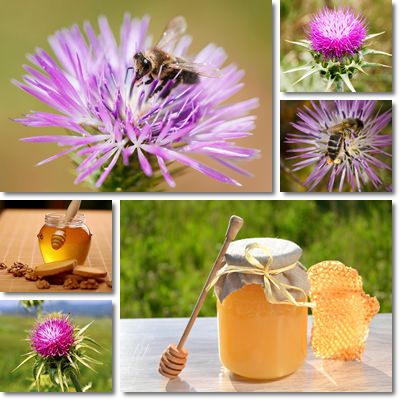Italian thistle honey, also called Cardoon honey, is a type of honey made from thistle plants native to the Mediterranean region. It is a very fine variety of honey, highly appreciated for both its taste and health benefits. Italian thistle honey is said to have hepatoprotective effects, stimulate digestion and exert a protective action on the stomach lining. Like all honeys, it is a great natural antibacterial that actively inhibits bacteria growth and reduces bacterial load, hence its use for improving symptoms of respiratory tract infections such as sore throat and skin appearance.
There is quite a great deal of confusion with regards to Italian thistle honey. The most confusing aspect is its composition. Not many people know that this particular variety is often obtained from several types of thistle species native to the Mediterranean area, including a plant species known as Cynara cardunculus, or artichoke thistle. The latter is highly appreciated as a culinary vegetable and its more prominent flower buds and stalks are eaten throughout Italy, northern Spain, Portugal and even some parts of France and northern Africa. Its taste is likened to that of artichoke, hence its alternative name.

What does thistle look like? The source of the renowned honey with the same name, thistle comprises a family of similar-looking flowering plants related to daisies and sunflowers. Thistles are characterized by prickly leaves and sometimes stems too and cup-like flower heads with a tuft-like appearance. Flowers are generally purple, red-purple or lavender-blue, but can also be yellow or white. Thistles look like flowering weeds and, because of their invasive nature, are even treated as such in some parts of the world. Nevertheless, their nectar and pollen is the source of the delicious thistle honey.
Italian thistle honey is a particular variety made from the nectar and pollen of thistle species native to and present in the Mediterranean Basin. Where is Italian thistle honey produced more exactly? Sardinia, Sicily, Calabria and Elba are the main producers of Italian thistle honey.
What does Italian thistle honey look like? Also called ‘miele di cardo’ in Italian (the English equivalent of which is Cardoon honey), this variety usually has a clear, light yellow color and takes on a beige appearance when crystallized. Compared to acacia honey, this variety is quick to crystallize, indicating a higher content of glucose.
What does Italian thistle honey taste like? The honey stands out as having sweet floral notes and a medium taste intensity. However, depending on the type of thistle nectar predominant in the honey, it may taste slightly earthy, leathery or almondy or have an anise-like aftertaste.

What about the benefits?
What is Italian thistle honey good for? Raw, unprocessed, unheated Italian thistle honey is great for a variety of ailments, from respiratory tract infections to hypoglycemia and acne. The following are the most noteworthy 9 properties and health benefits of the Italian Cardoon variety:
1) Antiseptic action. The antiseptic action of is a result of three factors: a high hydrogen peroxide content, a low moisture content and acidic pH. Hydrogen peroxide occurs naturally in most honey varieties when an enzyme secreted by honey bees and called glucose oxidase interacts with a simple sugar from the honey called glucose. The amount of hydrogen peroxide accounts for the antimicrobial potential of the honey, with significant differences occurring within honeys from the same region and the same plant species.
2) Great for sore throat and respiratory infections. Whenever I have a sore throat, I take one tablespoon of raw, unprocessed, unheated and undiluted honey several times a day and avoid eating or drinking anything for up to an hour afterwards. I find this extremely helpful for calming soreness and inflammation. For me, this remedy is good for relieving cough as well as improving the evolution of upper respiratory tract infections. Such effects can be explained by the hydrogen peroxide content of the honey which helps reduce bacterial load and inhibit growth and by the specific viscous texture which makes honey adhere to the lining of the throat, creating a sort of protective coating that prevents further irritation and allows it to heal.
3) Good for gastritis. Honey is known to soothe an upset stomach. It is recommended to take one tablespoon of raw, unprocessed, unheated honey on an empty stomach, preferably after waking up in the morning, and avoid eating or drinking for half an hour to an hour. The thick, viscous consistency and the antimicrobial properties of the honey not only protect the stomach lining, preventing further irritation, but also allow it to heal, making honey a good food for gastritis.
4) Promotes good digestion. Cardoon honey is said to help ease digestion by stimulating the release of bile into the small intestine. This is why some people eat some honey after a more substantial meal, to encourage easy digestion.
5) Great for skin health. Cardoon honey, like most honeys, makes a wonderful natural face mask, ideal for dull, oily and even acne prone skin. I usually apply a relatively thin layer of the raw, unprocessed honey on my face, wait 15-20 minutes then wash it off with lukewarm water. My skin looks radiant, more luminous afterwards and it feels tighter and hydrated, without the excess sebum. Because of its slightly astringent effect, I feel honey is great for preventing acne breakouts as well. I also find it useful for uneven skin tone and generally use most types of light-colored honeys as face masks for this purpose.
6) Hepatoprotective action. Thistle honey in general boasts hepatoprotective effects. Not only does it aid digestion by supporting the release of bile into the small intestine, but it also contains antioxidant polyphenols which are believed to be protective of liver health. Silymarin, one such antioxidant found milk thistle, is currently being extracted and employed as an adjuvant therapy for the treatment of liver disease and prevention of liver cancer.
7) Cardiovascular benefits. Cardoon honey is said to help improve blood circulation and thus contribute to better cardiovascular health. However, its effects in this respect are not reported to be extraordinary, so it might be best not to rely exclusively on the honey and seek medical advice if you have any concerns regarding your cardiovascular health.
8) Rich in antioxidants. The variety is a rich source of polyphenolic antioxidants, notably flavonoids. Antioxidants protect against cell damage known as oxidative stress and prevent it from building up, creating inflammation and disrupting normal cell function. This is said to contribute to better prevention against chronic disease.
9) Source of essential nutrients and energizing effect. Italian thistle honey contains trace amounts of multiple different vitamins and minerals, simple carbohydrates, enzymes, antioxidants and all sorts of elements with a beneficial action on human health. Being made of natural sugars for the most part, it has an exceptionally strong energizing effect and is a perfect snack for restoring energy and preventing hypoglycemia. Its special composition makes it a far better choice of a snack than candy and other sweets abounding in refined sugar or artificial sweeteners.
Conclusion
Cardoon or Italian thistle honey is not only a delicacy, but also a great food for good health, provided, of course, it is not processed, heated, diluted or faked, in which case it loses its beneficial properties. It is generally recommended for use for liver protection, digestion support, respiratory infections, acne and hypoglycemia. However, because it contains pollen from the flowers, anyone allergic to thistle is advised to avoid consumption. Also, if you have multiple pollen allergies, daisy-family allergies or honey allergies, then it might be best to have a skin allergy test before enjoying Italian or any thistle honey varieties.
